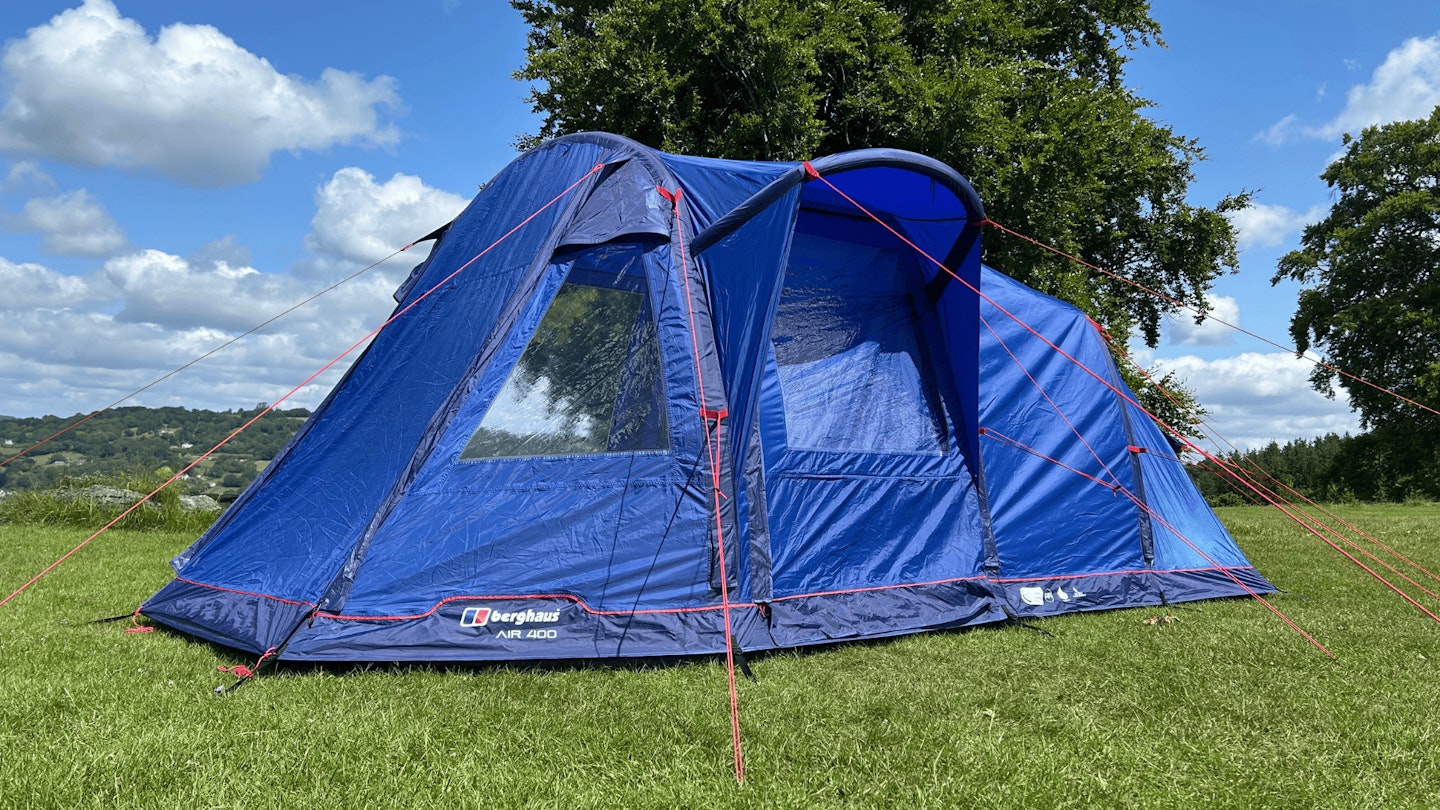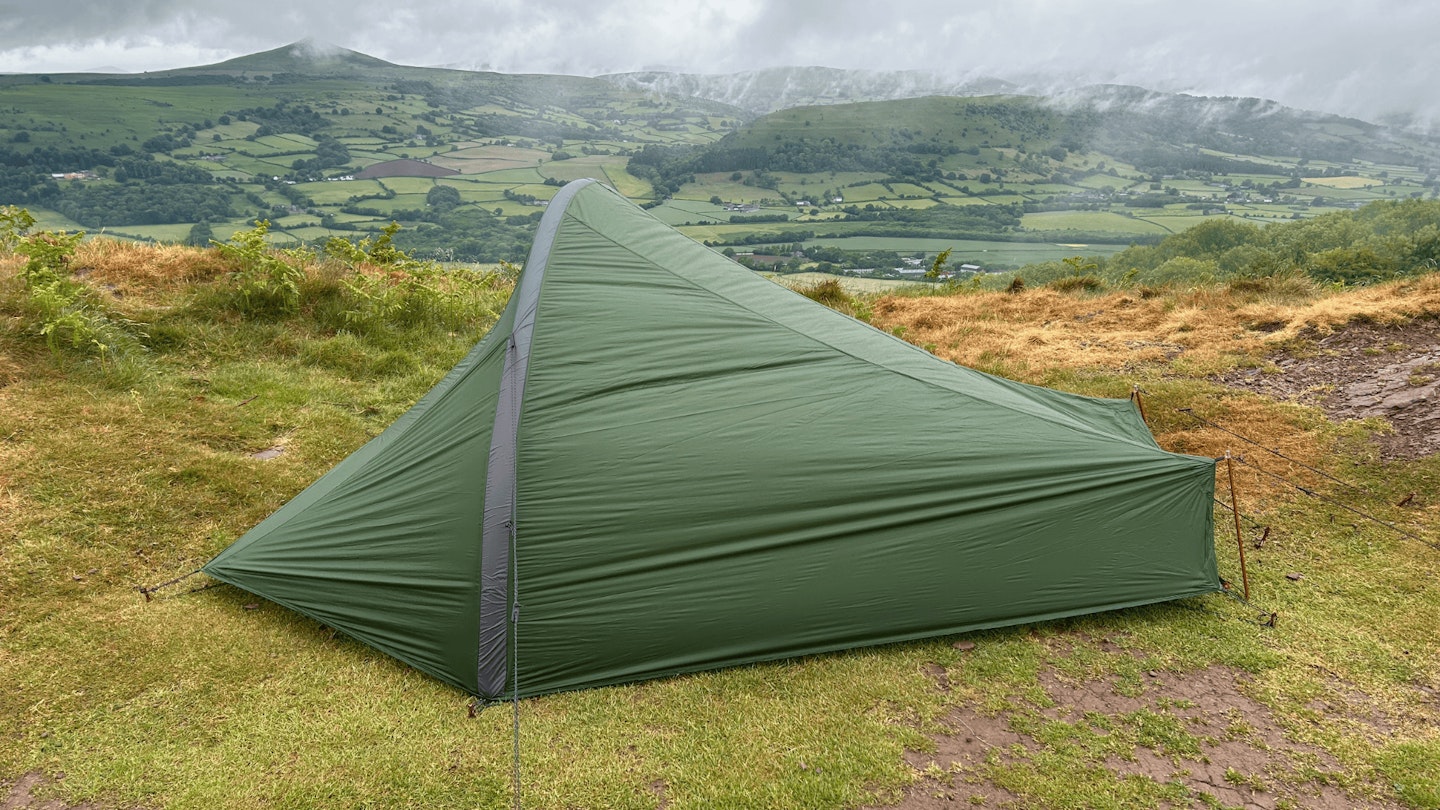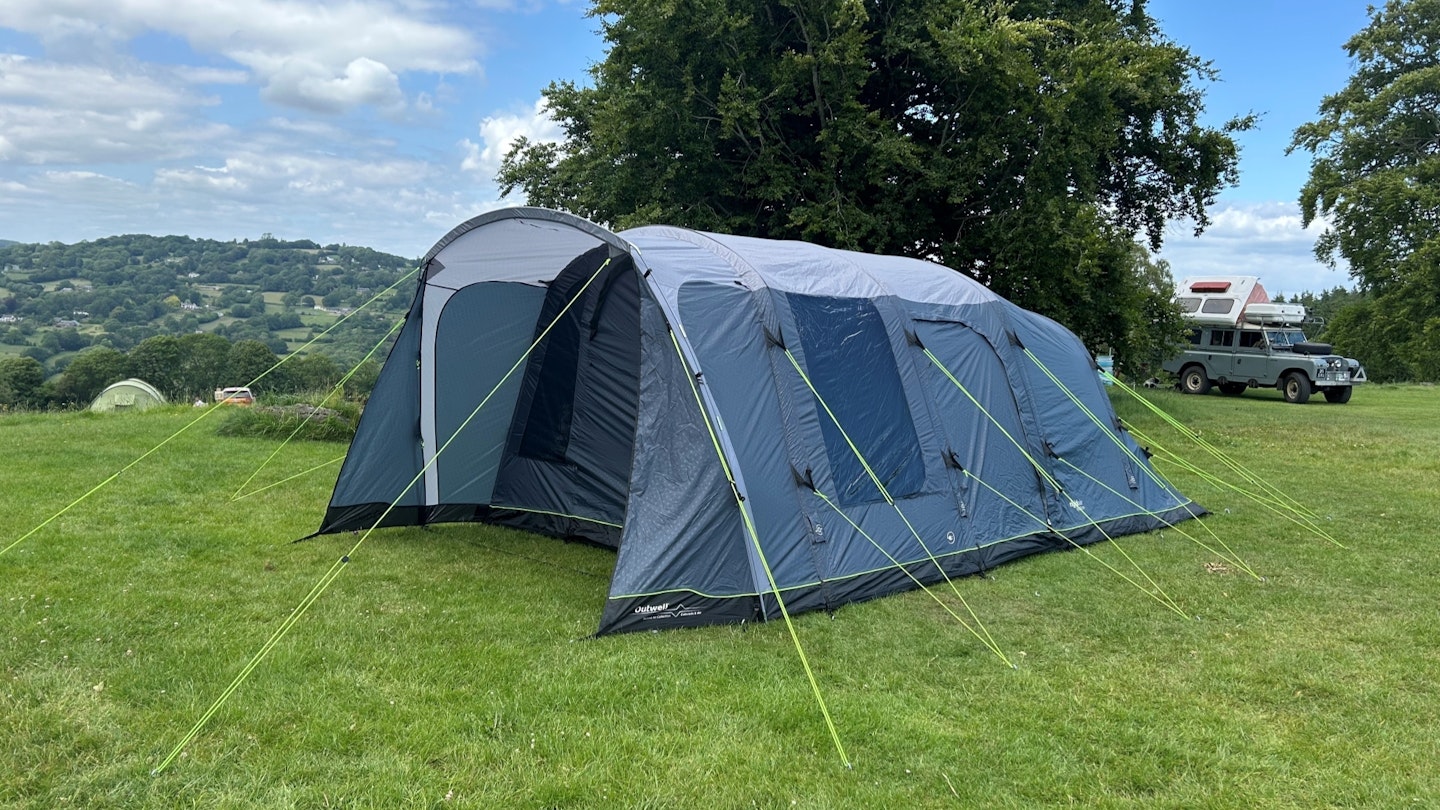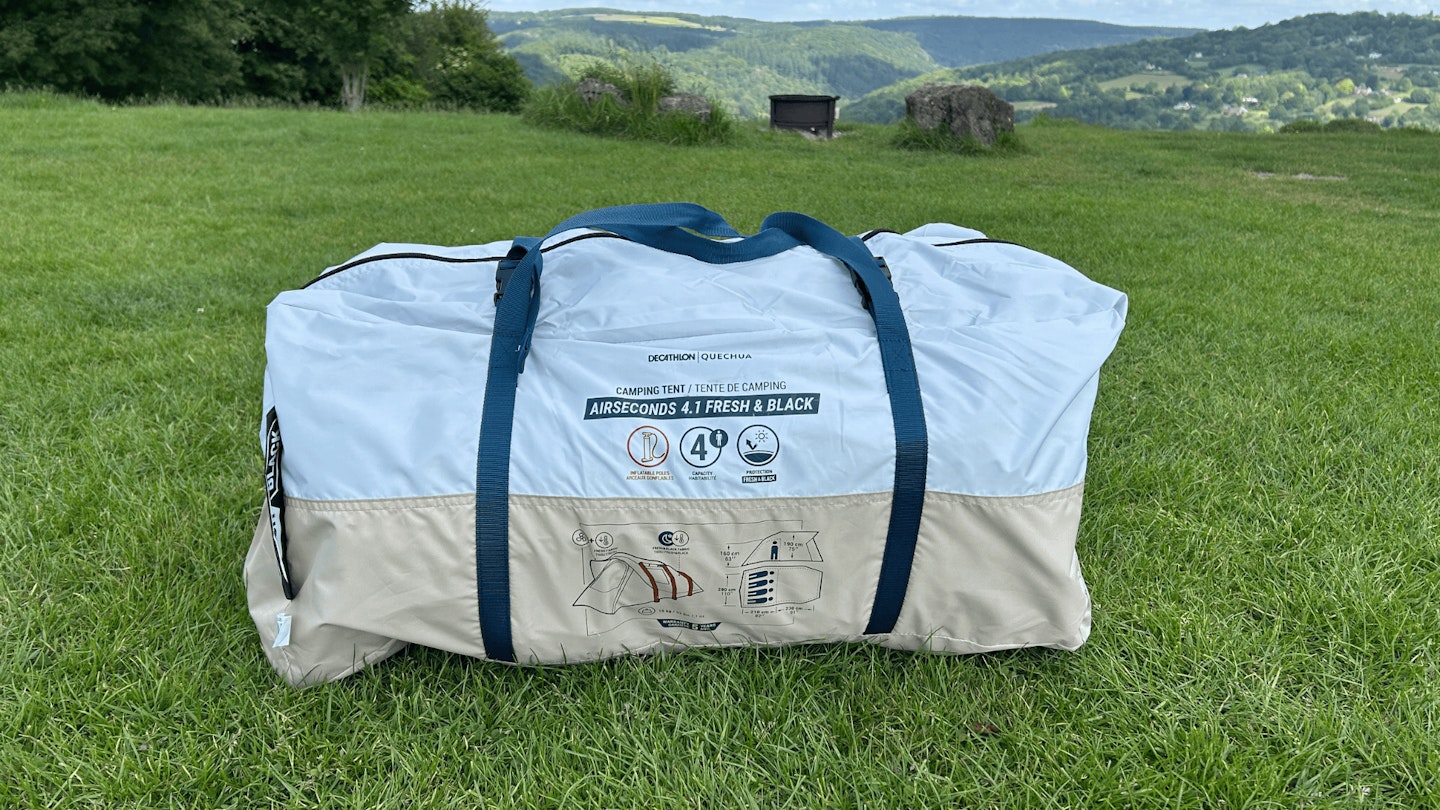Over the past fifteen years, finding the best inflatable tent has become a top priority for those seeking an easier, faster alternative to traditional pole tents. In this roundup, we’ve tested half-a-dozen of the best new inflatable tents available today.
As we get into the swing of the UK summer camping season, many of us will be eyeing up trips with the family and wild camping adventures in the hills, fells and mountains. If you’re in the market for a new tent, the sheer variety of styles on offer these days is almost overwhelming.
As any experienced campers know, setting up a pole-based family tent can be a real faff. Trust us, we've been there – it's getting dark, the kids are hungry and the tent is a jumbled confusion of poles and fabric that resembles a five year old's scribble more than it does a shelter.
With the best inflatable tents, you'll avoid the "why are you just standing there, come help me", "no, this pole goes in here" and "thanks a bunch, now you've snapped it", while your campsite neighbours look on with amusement from their reclining camping chairs.
So, to help you make the most informed choice possible, we've put a wide range of inflatable tents to the test. These are suited to a wide range of uses, from the backpacking-oriented Alpkit Aeronaut 2, to camping with the whole family in the Outwell Colorado 5 Air.
Best inflatable tents at a glance
Best inflatable tent overall: Outwell Colorado 5 Air tent
Best value inflatable tent: Quechua 4-Man Inflatable Camping Tent
Best compact inflatable tent: Alpkit Aeronaut 2
How we tested the best inflatable tents

These inflatable tents were tested by experienced camper Alex Foxfield. An expert on all things outdoor gear, Alex has been testing and reviewing camping kit and tents for many years.
During the test period, Alex spent several days testing each tent in turn: car camping with his young family, pitching the tents for extended periods in his garden and, in the case of the Alpkit Aeronaut 2, heading out for wild camping adventures in the Bannau Brycheiniog (Brecon Beacons) National Park.
This enabled him to assess the liveability, ease of use and quality of each shelter, as well as their ability to resist the wind. The extended periods the tents were pitched in the garden allowed him to observe how they coped with rain too – as, fortunately, you can’t guarantee sunshine on a weekend away!
For more info about how we get products in for review, read about how we test here.
Best inflatable tents for 2025
The Colorado 5 Air is a cracking tent. It's classically shaped, with four air beams and one central archway. There's two spacious bedrooms, plus a porch and a living area most adults can stand up in (it's 195cm tall at its apex). It takes a little longer to pitch than some family air tents, but it’s still pretty easy given how large this tent is.
Family tents often have two equally sized bedrooms, but the Colorado 5 Air has a master bedroom, which fits three adults side-by-side, and a kids’ bedroom which fits two adults at a squeeze. You can also open it out completely to create one huge space.
On test, I found it performed well in wind and rain, and based on its stats and design I reckon it'd be able to cope with a prolonged downpour. One of my favourite features is the magnetic central opening, which means you can sneak out ninja-style when nature calls in the middle of the night.
Overall, this is a wonderfully liveable tent: easy to pitch, spacious and cleverly designed. For longer family camping trips, this premium tent is a great shout.
See our full Outwell Colorado 5 Air review here.
Pros
- Innovative magnetic bedroom opening
- Customisable bedrooms
- Premium feel and design touches
Cons
- Stuff sack isn’t the best
- Rudimentary design of the peg and pole bags
- Heavier and larger pack than most
| RRP: | £944.99 |
| Internal dimensions: | 545 x 320cm |
| Internal peak height: | 195cm |
| Packed size: | 78 x 40 x 45cm |
| Weight: | 26.6kg / 4st 2.6lbs |
The Quechua 4-Man Inflatable Camping is made up of three air beams, two of which are taller than the third, forming a sloping tunnel. It's spacious, but not palatial. The living area reaches up to 190cm, which gradually lowers to the 160cm tall bedroom entrance. I found that it easily fits two adults and two kids.
Where this tent really excels is in the heat. The bedrooms are amazingly dark and the tent's 'Fresh & Black' fabrics reflect the heat of the sun. The bedroom also has an airy ventilation hatch. You get a pole attachment at the front which creates an awning – though I'd question if it's worth the effort, as it's very small.
With a hydrostatic head of 2,000mm, it should stand up to most downpours, but it's not as impressive as some competition. Nor is it the most wind resistant inflatable tent you can get. But it still performs well-enough for most car camping holidays, as long as there aren't any named storms on the horizon.
The Quechua 4-Man couldn't be any easier to setup. It's basically pre-assembled, so all you need to do is inflate the beams and install the awning pole and top bar. Make sure you get invest in a pump though, as annoyingly it isn't included.
See our full Quechua 4-Man Inflatable review here.
Pros
- Cool, even on hot days
- Good interior storage components
- Impressively dark bedroom
- Quick and easy to pitch and pack away
Cons
- Pump not included
- No option to segregate bedroom
- Window shutter design could be improved
| RRP: | £349.99 / $499 |
| Weight: | 15kg / 2st 5lb |
| Packed size: | 65 x 40 x 42cm |
| Internal dimensions: | 480 x 290cm |
| Internal peak height: | 190cm |
- Fresh, heat-reducing fabric
- Easy assembly and dismantling
- Effective blackout materials for a good night's sleep
- Simple repairs process in case of damage
- Well ventilated to keep temperatures down
The Vango Sierra Air 500 is a great example of why air tents are particularly great for families. With just three beams to pump up and a single pole for the porch canopy, pitching is fast, simple, and can realistically be done by one person in about 20 minutes.
The included dual-action pump with pressure gauge takes out the guesswork, while sturdy guylines and Vango’s TBSII tension system keep the tent taut and secure once it’s standing.
The Sierra Air 500 is designed with summer camping in mind. Large mesh panels, side vents and a rear bedroom vent give it outstanding airflow, and the extended porch canopy offers shade and shelter.
At 19kg and an 80 x 38 x 38cm pack size, it’s a relatively portable option compared with bulkier air tents, yet still robust enough thanks to its Sentinel Dynamic Weave fabric and 4,000mm hydrostatic head rating.
Inside, you get two bedrooms separated by a toggle-in divider, each big enough for a double mattress. The living area isn’t the most generous – fine for four campers, but it can feel cramped if you bring lots of kit. The canopy helps here, extending the usable space outdoors in decent weather.
This isn’t the most cavernous air tent in Vango’s line-up, but for campers who prioritise easy pitching, summer-ready ventilation and a pack size that won’t dominate the boot, the Sierra Air 500 makes an excellent choice.
Read our full Vango Sierra Air 500 review.
Pros
- Great ventilation for hot days
- Decent pack size and weight
- Easy to pitch and pack down
- Extended canopy is genuinely useful
Cons
- Living area feels small unless you pack lightly
- Only one way in
| RRP: | £660 |
| Weight: | 19.14kg |
| Packed size: | 80x38x38cm |
| Dimensions: | 325x460cm |
| Internal peak height: | 195cm |
The Berghaus Air 400 Nightfall is a family tent that's easy to use and very good value. Though its RRP is high (£1,050), you can currently find it for much less than this amount.
I found it was the quickest to set up out of all of the six inflatable tents I tested, taking just 23 minutes to finalise. The pack down took just over 11 minutes, which is equally impressive. The stuff sack is well designed. It has a U-shaped zipper, which means you can open it up wide and easily drop the tent inside.
The size is pretty standard for a four-person tent, but you can get more spacious options. The bedroom is split into two blacked-out pods, with a removable sheet of fabric between the two. There's a bright living space, while the bedrooms are appropriately dark.
This tent should be able to withstand biblical downpours – there's a hydrostatic head rating of 6,000mm, which is double that of most of the wild camping tents we've tested. It's designed to withstand strong winds as well, with sloped sides, a small-ish surface area and guylines.
See our full Berghaus Air 400 Nightfall review here.
Pros
- Super quick to set up and pack down
- Excellent stuff sack with wheels
- Bright living space, dark bedrooms
Cons
- Not the largest 4-person option
- Bedrooms could be wider
| RRP: | £1,050 |
| Weight: | 20.5kg / 3st 3.2lb |
| Packed size: | 80 x 46 x 39cm |
| Internal dimensions: | 495 x 280cm |
| Internal peak height: | 200cm |
The Eurohike Genus 800 is a large inflatable tent, symmetrically designed with a with a central living space and two blackout bedrooms on each side.
It's impressively compact and lightweight, at 12.8kg. It officially fits eight people, but I'd say this would be a squeeze. The bedrooms aren't big enough for two standard-sized double air beds, but can fit four single beds very close together. It'd comfortably fit 4-6 people.
One of the standout features of the Eurohike Genus is its quick pitching – I found it only needed half-an-hour, which is pretty good for such a large tent. The carry sack is a foldable sheet of fabric, which makes packing away simple and effective.
Its waterproofing and wind protection is above average. I’d back it when faced with anything up to one of those named storms that sweep in off the Atlantic.
This tent is also brilliantly ventilated, with mesh living room windows and bedroom panels, as well an airy living space. It's worth noting that this does mean that determined insects can get into the living space.
Overall, this is a simple yet effective air tent with two separate bedrooms and some handy features, ideal for family camping.
See our full Eurohike Genus 800 review here.
Pros
- Two separate bedrooms
- Impressively compact and lightweight
- Wonderfully quick and easy to pitch
- Interior storage compartments
Cons
- Smaller living area than some
- Bedrooms not roomy enough for twin doubles
- Slightly uninspiring colour
| RRP: | £850 |
| Internal dimensions: | 595 x 250cm |
| Internal peak height: | 190cm |
| Packed size: | 73 x 38 x 36cm |
| Weight: | 12.8kg / 2st |
The Hi Gear Lavvu Airlite is an interesting hybrid, with a pole-type bar as well as an air beam. What you get is a tall, spacious shelter.
At 2.5m at its apex, this tent is uniquely high. There's a rectangular porch that widens into a spacious hexagon, which includes the bedroom area. It's designed for three people, but you could probably fit more, especially if some are little people.
I found I could get the tent fully set up in 23 minutes, which is the second fastest out of the six I reviewed. The only hassle was the bar, which holds the porch up and needs a bit of a wrestle to get in place (and disassemble).
At 17.5kg, it's pretty light for an inflatable tent. The living space is less spacious than it first seems, as it quickly tapers. The bedroom is wide enough to take at least three single camping mats. Annoyingly, it lacks inner storage pockets or blackout fabrics.
This is one of the most weather-proof air tents around. The Lavvu Airlite has a hydrostatic head rating of 4,000mm, which is much higher than backpacking tents designed for wilder conditions.
See our full Hi Gear Lavvu Airlite Tent review for more.
Pros
- High, airy and pleasant space
- Innovative magnetic bedroom closure
- Well ventilated
Cons
- No blackout fabrics for bedrooms
- Lack of internal storage
- Not as easy to pitch as some
| RRP: | £399 |
| Internal dimensions: | 590 x 440cm (widest) or 250cm (narrowest) |
| Internal peak height: | 250cm |
| Packed size: | 74 x 42 x 38cm |
| Weight: | 17.5kg / 2st 10.6lb |
At a first glance, the Alpkit Aeronaut 2 looks like a classic lightweight backpacking tent, with a hooped arch at one end which tapers towards the feet. However, upon closer inspection you'll see that the arch is in fact an air beam, not a pole.
The air beam makes it easier to squeeze this tent into a compact pack, and you don't get any pole-related faff.
The size is what you'd expect for a backpacking tent. It doesn't come with a pump, but handily you can use a bike pump. There's some good storage options inside, thanks to pockets and hanging loops.
It's quick and easy to pitch, and takes only four minutes to pack down according to my timings. Disappointingly, the pegs deform easily when placed in the ground. It's also not ideal that there's only one entrance and exit, so one camper will have to clamber over the other if nature calls during the night.
I'd say it's ideal for three-season wild camping adventures, but not tough enough for winter use. However, it's more windproof and weatherproof than most alternatives, and I found condensation wasn't an issue.
The Aeronaut 2 weighs 1.5kg, which is pretty decent for a three-season, two-person backpacking tent. An RRP of £200 delivers good value overall, and it's much cheaper than many less robust two-person tents.
See our full Alpkit Aeronaut 2 air tent review here.
Pros
- No poles to faff with
- Can be inflated with a bike pump
- Plenty of internal storage and hanging points
Cons
- Not as liveable as some
- Porch isn't the largest
- Pegs bend easily
| RRP: | £199.99 / $279.99 |
| Weight: | 1.5kg / 3lbs 5oz |
| Packed size: | 39 x 19 x 14cm |
| Internal dimensions: | 250 x 200cm |
| Internal peak height: | 105cm |
- Pitches in seconds, and even quicker to disassemble
- Simple repairs process
- Can be inflated with bike or even foot pump
What to look for in an inflatable tent

Size and structure
Most inflatable tents are designed with families or groups in mind: think large tunnel tents with multiple rooms. Having said that, you can get some smaller two-person backpacking options.
Consider the internal layout. Some inflatable tents have two separate sleeping compartments, others just one main space.
Most inflatable tents have a living space, but it's worth checking if this is big enough for you to stand in. Maybe you've got lots of gear and want to chuck a camping table in there, too, in which case check how much storage space there is.
Weight and packed size
While inflatable tents don't need poles, they’re not always lightweight or packable. We find that they're usually very bulky and heavy when packed away, so you need plenty of boot space and a good place to store them.
If you’re car camping, this may not be a major concern, but it’s worth checking the weight and dimensions when packed – especially if you’ll be carrying it any distance or trying to fit it into a small boot.
Features

Look for practical details that match your needs. Features like blackout bedrooms, sewn-in groundsheets, mesh ventilation panels and cable entry points for electric hookups can all add to your comfort. Some models even include porch extensions, which is helpful for creating extra space.
Windows are also handy to let some light in if you're cooped up inside because of poor weather. Meanwhile, hanging points are ideal so you can set up a camping lantern, while pockets are always welcome for organisation, both inside the bedroom and in the living space.
Setup and pack down
One of the key selling points of inflatable tents is ease of setup, but it’s still worth checking how intuitive the process is. Consider how many inflation points there are and how powerful the pump is (if, as you'd hope, one comes with the tent). Dual action pumps are preferred, as they'll push air into the valves both when pulled up and pushed down.
Inflatable tents can be much harder to pack down and put away than pole tents, because the air chambers are made of thicker material and less simple to roll/stuff away.
Here, a decent carry bag makes a world of a difference. Carry bags featuring a long zippered opening are much more practical than those with a drawstring opening at one end.
Ideally, the valves also have a lock function so they stay open when you're trying to roll the air out of them.
Build quality

As with any tent, materials matter. Check the denier (thickness) of the fabric, the quality of the zippers and the stitching around stress points. Higher-end models often use reinforced air beams and tougher flysheet materials to increase durability.
It's also helpful to see if the tent comes with a repair kit or replaceable valve system – small touches that can make a big difference in longevity.
Like usual, you'll also want to pay close attention to the tent pegs – are they robust enough to not bend in dry ground?
Weatherproofing
A good inflatable tent should keep you dry and comfortable in a range of conditions. Look for a high hydrostatic head rating (ideally 3000mm or more) for waterproofing, taped seams and a fully sewn-in groundsheet to prevent leaks.
It's important not to pull the beams out of their shape with the guy-lines, otherwise the tent may not perform as well in windy conditions.
Are inflatable tents any good?

The main advantage of an inflatable tent is that you don’t have to assemble poles, then thread them through the appropriate sleeves on the tent. This should make pitching quicker and easier, particularly when it comes to larger shelters – a game changer if you’re taking the kids camping on your own.
This innovation has also enabled manufacturers to tweak the designs of their family tent range, creating spacious shelters with steep walls.
What are the disadvantages of inflatable tents?
While inflatable tents offer a quick setup, they can be more difficult to put away than pole tents. Air beams need to be fully deflated and rolled carefully to fit back in the bag. They're also often more bulky and heavy, due to the air beams and heavy-duty materials.
And although most air beams are robust, they're less ideal for extreme conditions, as Trail's Gear Editor Ben found out when one of the air tubes exploded during a storm on the Isle of White. There's also a risk of punctures or leaks.
Are inflatable tents durable?

Yes, inflatable tents tend to be highly durable. Although they can puncture, their air beams are less likely to snap than poles, making them especially useful in windy conditions.
The best inflatable tents feature high-quality outer fabrics with strong waterproof ratings, taped seams and rugged zippers, ensuring they hold up well to the elements. As with any tent, durability can vary depending on the brand and model, so it’s important to choose a well-reviewed product and follow care guidelines.
How do I maintain and clean an inflatable tent?
To keep your inflatable tent in good condition, you should clean after each trip. This means shaking out any debris and wiping down the fabric. Always make sure your air tent is fully dry before storing it, otherwise it'll get mouldy. It's best to store your tent in a cool, dry place.
See our step-by-step guide on how to clean a tent for a more detailed overview.
Are inflatable tents suitable for all weather conditions?

Most inflatable tents are excellent for three-season camping and typical UK/European weather, but they're not suited for alpine expeditions or winter conditions.
Quality inflatable tents are stable in wind, waterproof in rain (if rated properly) and suitable for cool weather. Always choose a tent suited to your typical conditions and pitch it securely.
How long do inflatable tents last?
Like pole tents, a good quality inflatable tent can last anywhere from five to 10 years, or even longer with proper maintenance. Well-designed inflatable tents last longer, of course, but longevity also depends on how often you use it and whether you take good care of it.
There's also the question of how long the air inside the beams lasts. On longer trips, it's recommended to regularly re-inflate the beams. This will help the tent to withstand strong winds.
How do you pitch an inflatable tent?

Pitching an inflatable tent is broadly similar to pitching a standard poled tent. Having laid the footprint of the tent down on the ground, you typically stake out the corners before getting to work on the air beams.
These tend to have a single valve each, usually all on one side of the tent. Attach the pump and inflate to the required pressure, repeating the process on each beam.
They’ll begin to spring into shape and may require a bit of a nudge for the frame to become rigid and therefore operational. After this, it’s just a case of pegging the rest of the tent out and tensioning the guylines as explained in the instructions.
What happens if an inflatable tent gets a puncture?
The air beams on an inflatable tent are usually highly durable, with brands doing their upmost to protect them against punctures.
Most inflatable tents are supplied with a puncture repair kit for quick fixes on the fly. After any repairs, you can check the pressure of the beam using your pump and re-inflate.
For more serious bursts, some brands, such as Vango, offer a repair service. Other brands will send out a new beam and sleeve if the tent is still under warranty.
About the author

The chief tester of these inflatable tents, Alex, is a qualified Mountain Leader, avid wild camper and a family man, who enjoys camping in all its forms. An expert on all things outdoor gear, he’s been testing and reviewing camping kit and tents – from solo backpacking shelters to palatial family car camping tents – for many years.




































